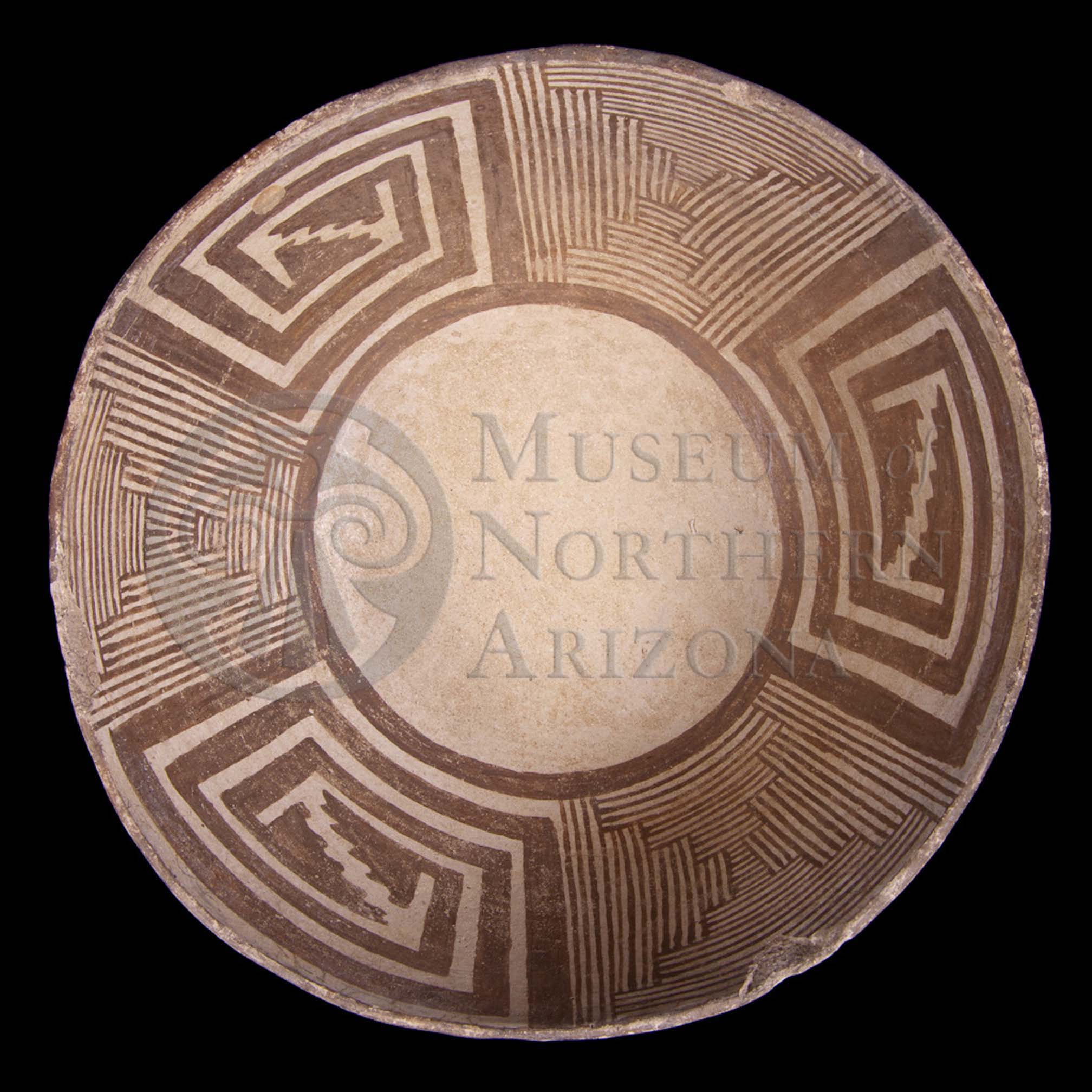
Mimbres Transitional (Style 2) bowl from the Museum of Northern Arizona collections. Click the image to open the Mimbres Style 2 gallery.
Mimbres Style 2 pottery is the transitional type between Mimbres Boldface (Style 1) and Mimbres Classic (Style 3). As with the other types, Style 2 pottery is concentrated in southern New Mexico north to the Upper Gila, east to around El Paso, Texas, and south into Chihuahua, Mexico, with vessels occasionally found as far west as west-central Arizona.
Archaeological Culture: Mimbres
Date Range: A.D. 950-1000.
Construction: Coiling and scraping.
Firing: In a reducing atmosphere; firing atmosphere often variable; fire clouds common.
Core Color: Brown, red, buff, light gray, or dark gray; often variable in cross-section; always buff, brown, or red when refired.
Temper: Quartz sand or crushed quartz, volcanic rock, or sherds; often fine and rounded.
Surface Finish: Bowl exteriors smoothed, unslipped; interiors smoothed, heavily white-slipped (chalky and often irregular), polished, painted.
Surface Color: White when slipped; when not slipped, grayish-brown, gray, or dark gray.
Forms: Bowls (predominate), jars, ollas, seed jars, effigies.
Decoration:
- Paint: Red, black, or in-between; red when fired in an oxidizing atmosphere; black, gray, or gray-brown when fired in a reducing atmosphere ; frequently mottled or piebald from inconsistent firing atmospheres.
- Pigment: Hematite.
- Design: Primarily interiors, occasionally exteriors; design to rim (early) or below, but touching rim band (late); straight line hatchure (early: coarse/wide, late: finer) bordered by bold lines; open, unpainted circle at bottom of bowl; rim band common; layouts quadrant (early) or mirrored; some figurative elements.
Comparisons: Cibola Paste/Mimbres Design: whiteware vessels painted with Mimbres designs, generally found in the Reserve area, Arizona and the Upper Gila Valley, New Mexico; typically unslipped. Distinguished from Style 1 by use of straight-line hatchure and/or central open circle and rim bands. Style III is more finely executed, with the design separate from the rim band(s). The slip on Chupadero Black-on-white cannot be scratched with a fingernail.
Other Names: Mimbres Boldface, Mangas Black-on-white, Mangus Black-on-white, Transitional, Mimbres Black-on-white, Classic Black-on-white.
Compiled from the following sources:
Barkwell Love, Lori. (2014) From the Inside: Paste Variation in Mogollon-Mimbres Ceramics from Woodrow Ruin in the Upper Gila, New Mexico. Presented at the 79th Annual Meeting of the Society for American Archaeology, Austin.
Scott, Catherine J. (1983) The Evolution of Mimbres Pottery. In Mimbres Pottery: Ancient Art of the Southwest, edited by S.A. Leblanc, pp. 39-68. Hudson Hills Press, Inc. New York.
Compiled by:
Meghann M. Vance, Northern Arizona University Anthropology Laboratories.
